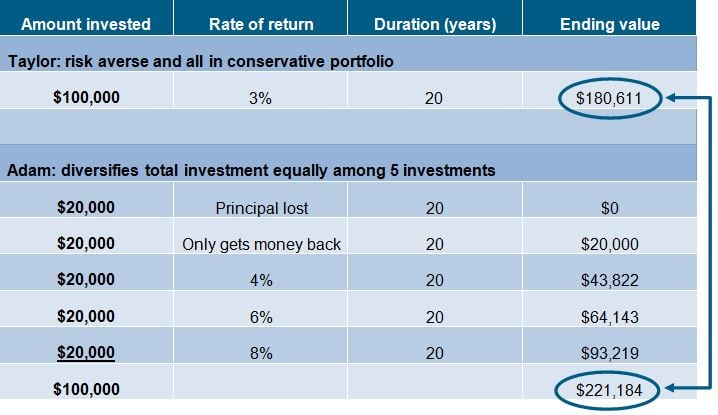
I’m sure many of you have heard the following statements. Perhaps you have made them yourselves.
“I don’t like taking risks with my money.”
“I can’t accumulate the amount of money I need by simply putting it all into a savings account or term deposits.”
“What happens if I put all of my money into an investment and then lose it all?”
Why not put all of my eggs into one basket if it looks good?”
“How does diversification work?”
Let’s look at two friends, Taylor and Adam.
Taylor is pretty conservative and nervous about investing in the market. She hates the roller coaster ride of the ups and downs in many investments and hates to lose money. She opts to put $100,000 into a long term bond and GIC portfolio earning an average annual rate of return of 3%.
Adam doesn’t like to lose money either. He recognizes that it’s hard to accumulate a significant amount of money if you don’t take any risk. He doesn’t believe in putting all of his eggs into one basket so to speak. Adam apportions the same amount of money into five different investments, each with a different amount of risk and opportunity for growth attached to them.
Both Taylor and Adam commit to sticking with their respective investment strategies for 20 years. The following table compares the results at the end of 20 years.
Diversification: risk and opportunity

For illustration purposes only; not intended to project performance of any particular investments
Taylor may have slept comfortably at night with her investment approach but she didn’t even double her money after 20 years. Adam experienced some setbacks but hung onto his investment approach. He lost all of his money in one investment and only managed to break even in another one. The balance of his investments earned 4%, 6% and 8% respectively on average each year over the 20 year period. The diversification paid off.
He more than doubled his initial total investment, earning over $40,000 more than Taylor. Taylor would have had to earn more than 4% over the same period of time just to match Adam’s results.
Adam’s strategy shows the opportunities and risks with diversification. He spread his risk. He managed to minimize the downside by apportioning his initial investment across a number of investment options, he managed to minimize the downside of some investments and benefit from the opportunities of other investments. After 20 years, it paid off for him, as the scenario illustrates.
The math works. That said, the effectiveness of a diversification strategy does depend on discipline, proper evaluation of your risk tolerance and then appropriate investment portfolio composition.
Working with an accredited financial advisor well versed in investments may help you optimize your return on your investments, minimize the downsides that are part and parcel of investing in the market and help you reach your goals.
| Talk to an investment advisor today to learn more |


